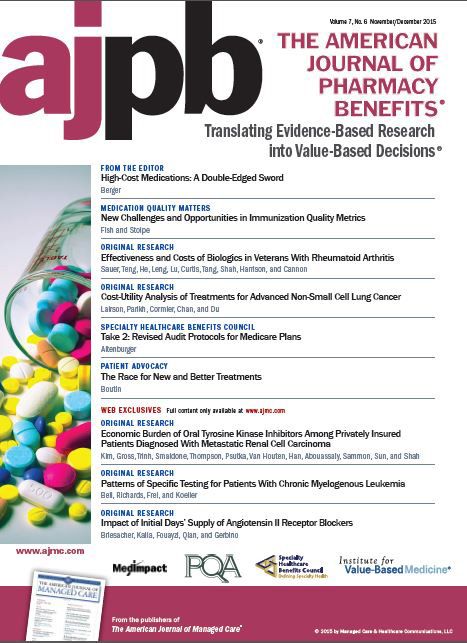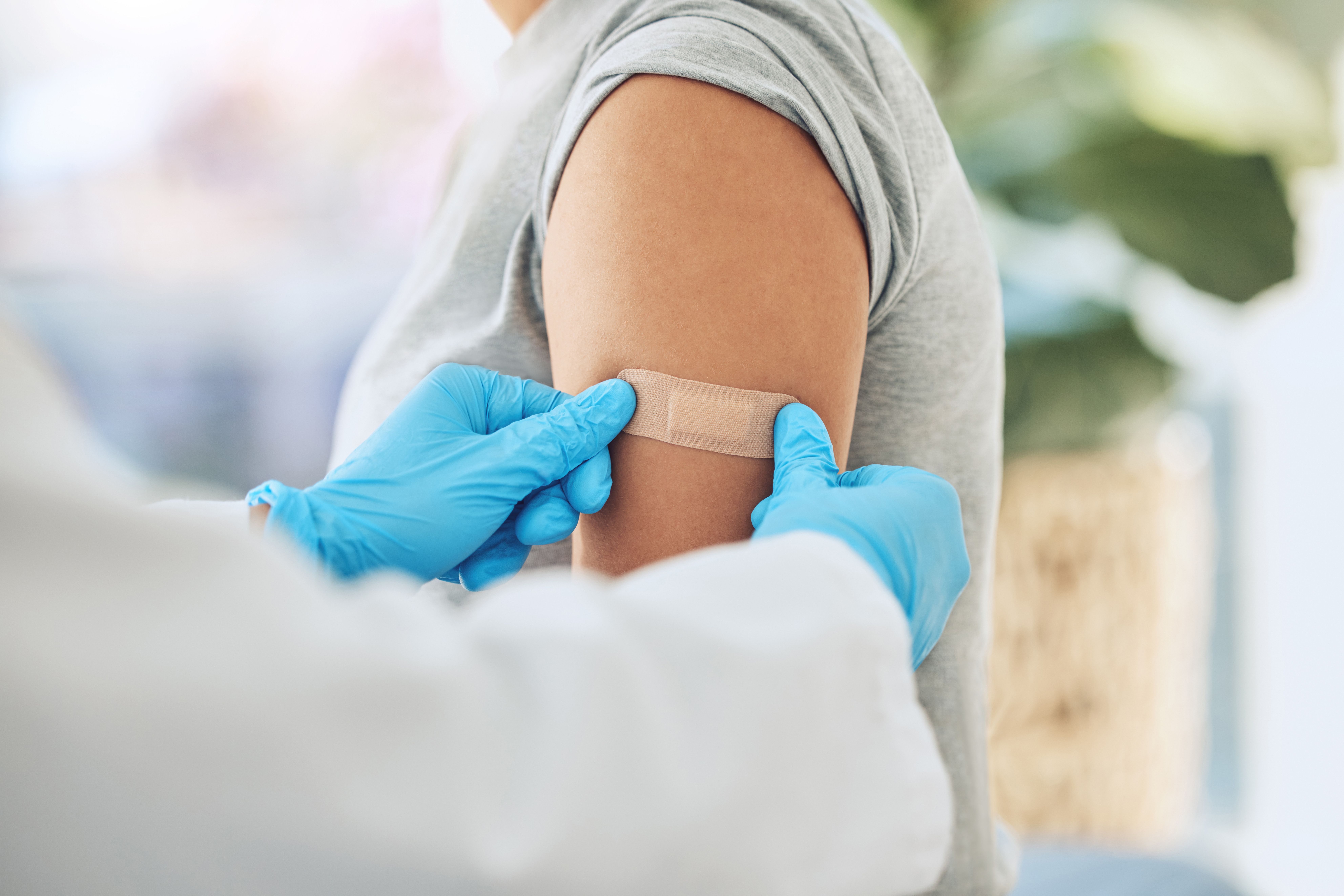Publication
Article
AJPB® Translating Evidence-Based Research Into Value-Based Decisions®
New Challenges and Opportunities in Immunization Quality Metrics
In the United States, adult immunization rates are substandard. Opportunities exist to improve these rates trough quality performance measurement, but not without challenges.
PRACTICAL IMPLICATIONS
Although rates of adult immunizations are minimal, improvement efforts are being made through performance measurement. This article:
- Provides insight into the illness and economic burden of vaccine-preventable disease.
- Describes challenges associated with developing quality performance metrics related to immunizations.
- Identifies new opportunities to utilize Immunization Information Systems to increase adult immunization.
Despite the availability of immunizations that have been demonstrated to reduce the risk of vaccine-preventable disease, reported rates of immunization remain low, especially among the adult population. This has contributed to a significant disease burden. In 2013, the CDC identified over 53,000 deaths that occurred due to pneumonia, while only 60% of seniors and 30% of high-risk patients received the pneumococcal vaccination.1,2 In that same year, it is estimated that in adults 50 years or older, influenza, pneumonia, herpes zoster, and pertussis combined cost the US healthcare system approximately $26.5 billion.3
On average, seasonal influenza alone costs about $10.4 billion in direct medical expenditures and nearly $87 billion from decreased work productivity through days missed and job loss, as well as death.4 Similarly, vaccination against influenza during the 2013 to 2014 season prevented more than 7 million illnesses and 90,000 hospitalizations, according to CDC projections.5 Nevertheless, with only 42% of adults vaccinated against influenza during the 2013 to 2014 season, there were significant missed opportunities to reduce disease burden and disease-associated economic drag.
Improving immunization rates and reducing preventable infectious disease are 2 of the goals outlined in Healthy People 2020—the 10-year national objectives outlined by the US Department of Health and Human Services for improving the health of all Americans,6 with over 80 objectives to reduce preventable diseases and increase the rate of immunization among patients of all ages. Healthy People 2020 calls for an increased percentage of vaccination against influenza to 70% of adults 18 years or older, pneumonia to 90% of adults 65 years or older, and herpes zoster to 30% of adults 60 years or older. While rates for some immunizations are trending upward, there remain significant gaps between current vaccination rates and the goals articulated within Healthy People 2020.7
One lever to improve immunization assessment, administration, and documentation is through the utilization of healthcare quality metrics. Immunization measures are currently included in several of the 26 federal quality and performance programs (Table 18). The types of immunization measures used include assessment of patient or healthcare provider immunization status, immunization administration, as well as 1 structural measure for immunization reporting.
Although many state, federal, and other quality programs have adopted immunization quality metrics, there are still many measurement gaps. Most immunization measures that have been developed assess influenza and pneumococcal vaccination. In 2014, the National Quality Forum (NQF) convened an Adult Immunization Committee to identify and prioritize measure gaps for adult immunization.9 In addition, the committee was charged with considering “harmonization and alignment of measures; costs and burden of measurement; measurement of disparities; and availability of data” in their identification and prioritization process.9 The Committee identified 10 measure gap areas for the focus of measure development. These measure gaps can be found in Table 2.9
Many challenges exist in the ability to develop measures in these areas due to underdeveloped and disparate data sources. Data to inform immunization quality metrics comes from a variety of sources, including administrative claims, Immunization Information Systems (IIS), electronic health records (EHRs), paper-based records, and patient surveys.9 One example of the use of patient surveys is the pneumococcal vaccination status for older adults measure, included in the Healthcare Effectiveness Data and Information Set (HEDIS).10 This measure uses patient-reported responses to questions asked on the Medicare Consumer Assessment of Healthcare Providers and Systems (CAHPS) survey. The measure, in this instance, conveys the proportion of respondents who responded “Yes” to the question, “Have you ever had a pneumonia shot? This shot is usually given only once or twice in a person’s lifetime and is different from the flu shot. It is also called the pneumococcal vaccine.”11
With the increasingly nuanced vaccination schedules associated with certain vaccines in the CDC’s Advisory Committee on Immunization Practices (ACIP), data sourcing for immunization measures are being called into question.12 In August of 2015, CMS announced in the Federal Register a final rule including changes to the Hospital Inpatient Quality Reporting System. The changes included the removal of a pneumococcal vaccine measure because it was “not feasible to implement the measure specifications that incorporated the new guidelines given their complexity.”13
CMS goes on to specify that “in order to implement the measure consistent with new [ACIP] guidelines, providers would need reliable, detailed data on: 1) whether or not a pneumococcal vaccine was previously administered; 2) which type of pneumococcal vaccine (PCV13 vs PPSV23) was administered; and 3) when it was administered.” CMS suggests that a national registry of patient vaccination records could provide a solution to the challenge of data sourcing.13
CMS’ rule recognizes that better utilization of and integration between EHRs and IISs to capture vaccination records is vital to increasing not only the amount of data surrounding adult immunizations, but also the integrity of the data collected. Considering immunization information comes from multiple—and in some cases, dubious—sources there is a need for robust collection mechanisms. Immunization information systems are confidential, population-based, computerized databases that record all immunization doses administered by participating providers to persons residing within a given area.14
Also referred to as immunization registries, IISs serve as a tool at both the individual and population level, providing information to a wide range of stakeholders, including public and private care providers, public health programs, emergency responders, and many others.14 In 2012, the CDC reported that adult participation—defined as having 1 or more vaccinations administered to adults documented in a registry—ranged from 0.5% to 85.4%, with an average of 25%.15
The Pharmacy Quality Alliance (PQA) is a nonprofit multi-stakeholder, consensus-based membership organization that collaboratively promotes appropriate medication use and develops strategies for measuring and reporting performance information related to medications. PQA is currently developing a measure called Immunization Information System Reporting that aims to capture the rate at which adult vaccinations are reported into an IIS. The measure calculates the rate of reporting vaccinations to an IIS by using medical and prescription claims and correlating the claims data to the record of immunizations in the IIS.
The information captured by the ISSR measure provides insight into provider-appropriate registry documentation. Ensuring that individuals receive all vaccines due—without duplicative or unnecessary doses—requires that complete immunization data be available to vaccine providers. Access to comprehensive patient immunization history drives improved quality of patient care and, ultimately, the reduction of vaccine-preventable disease in the population.16
Although adult immunization rates in the United States are substandard, efforts are being made to optimize them. The current use of performance measures in federal quality and performance programs has helped, along with new development efforts of immunization metrics where measurement gaps have been identified. Challenges certainly exist with both measurement and development of new measures, and the solutions will lie in more robust data sources. There is a need to continue to enhance IIS and EHRs across the nation to provide more reliable data sourcing to inform immunization quality metrics.
Author Affiliations: Pharmacy Quality Alliance (HMF, SS), Springfield, VA.
Funding Source: None.
Author Disclosures: The authors report no other relationship or financial interest with any entity that would pose a conflict of interest with the subject matter of this article.
Authorship Information: Concept and design (HMS, SS); acquisition of data (HMS, SS); drafting of the manuscript (HMS, SS); critical revision of the manuscript for important intellectual content (HMS, SS); administrative, technical, or logistic support (SS); and supervision (SS)
Send correspondence to: Hannah M. Fish, PharmD, CPHQ, Pharmacy Quality Alliance, 6213 Old Keene Mill Ct, Springfield, VA 22152. E-mail: [email protected].
REFERENCES
- Williams WW, Lu PJ, O’Halloran A, et al; CDC. Non-influenza vaccination coverage among adults—United States, 2012. MMWR Morb Mortal Wkly Rep. 2014;63(5):95-102.
- Deaths: final data for 2013, detailed tables. National Vital Statistics Reports. 2015;64(2). CDC website. http://www.cdc.gov/nchs/data/nvsr/nvsr64/nvsr64_02.pdf. Accessed November 1, 2015.
- McLaughlin JM, McGinnis JJ, Tan L, Mercatante A, Fortuna J. Estimated human and economic burden of four major adult vaccine-preventable diseases in the United States 2013. J Prim Prev. 2015;36(4):259-273.
- Molinari NA, Ortega-Sanchez IR, Messonnier ML, et al. The annual impact of seasonal influenza in the US: measuring disease burden and costs. Vaccine. 2007;25(27):5086-5096.
- Reed C, Kim IK, Singleton JA, et al; CDC. Estimated influenza illnesses and hospitalizations averted by vaccination—United States, 2013-14 influenza season. MMWR Morb Mortal Wkly Rep. 2014;63(49):1151-1154.
- Immunization and infectious diseases. HealthyPeople.gov website. http://www.healthypeople.gov/2020/topics-objectives/topic/immunization-and-infectious-diseases. Updated November 5, 2015. Accessed November 5, 2015.
- Williams WW, Lu PJ, O’Halloran A, et al; Centers for Disease Control and Prevention. Vaccination coverage among adults, excluding influenza vaccination—United States, 2013. MMWR Morb Mortal Wkly Rep. 2015;64(04):95-102.
- PQRS training module: quality measurement 101. CMS website. https://www.cms.gov/eHealth/downloads/eHealthU_PQRSQualityManagement101.pdf. Updated August 2014. Accessed November 2015.
- Priority setting for healthcare performance measurement: addressing performance measure gaps for adult immunizations. National Quality Forum website. https://www.qualityforum.org/Publications/2014/08/Priority_Setting_for_Healthcare_Performance_Measurement__Addressing_Performance_Measure_Gaps_for_Adult_Immunizations.aspx. Published August 15, 2014. Accessed November 1, 2015.
- HEDIS 2015, volume 2: summary table of measures, product lines and changes. National Committee for Quality Assurance website. http://www.ncqa.org/Portals/0/HEDISQM/Hedis2015/List_of_HEDIS_2015_Measures.pdf. Accessed November 2, 2015.
- Medicare Advantage and Prescription Drug Plan CAHPS Survey. Medicare Advantage and Prescription Drug Plan CAHPS website. http://ma-pdpcahps.org/Content/SurveyInstruments.aspx#SurveyMaterials. Updated October 29, 2015. Accessed November 5, 2015.
- Recommended adult immunization schedule—United States, 2015. CDC website. http://www.cdc.gov/vaccines/schedules/downloads/adult/adult-schedule.pdf. Accessed November 1, 2015.
- CMS-1632-F and IFC, CMS-1632-CN2 [final rule and correction notice]. CMS website. https://www.cms.gov/Medicare/Medicare-Fee-for-Service-Payment/AcuteInpatientPPS/FY2016-IPPS-Final-Rule-Home-Page-Items/FY2016-IPPS-Final-Rule-Regulations.html. Published August 17, 2015. Accessed November 5, 2015.
- Immunization Information Systems (IIS): about immunization information systems. CDC website. http://www.cdc.gov/vaccines/programs/iis/about.html#program. Updated May 15, 2012. Accessed November 1, 2015.
- Immunization Information System functional standards, 2013-2017. CDC website. http://www.cdc.gov/vaccines/programs/iis/func-stds.pdf. Published December 7, 2012. Accessed November 1, 2015.
- CDC. Progress in Immunization Information Systems—United States, 2012. MMWR Morb Mortal Wkly Rep. 2013;62(49):1005-1008.

Newsletter
Stay informed on drug updates, treatment guidelines, and pharmacy practice trends—subscribe to Pharmacy Times for weekly clinical insights.






